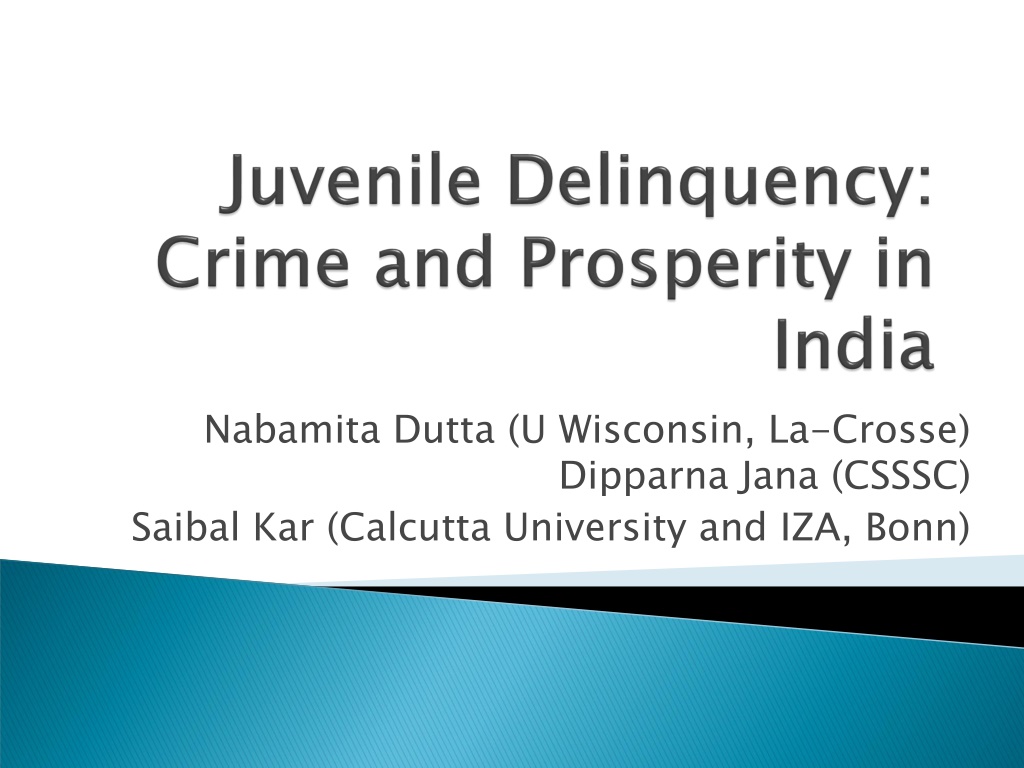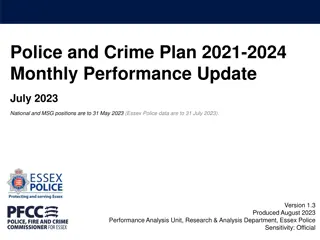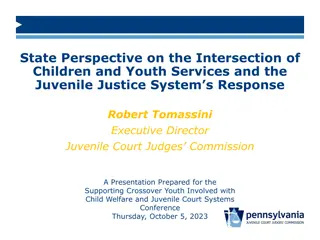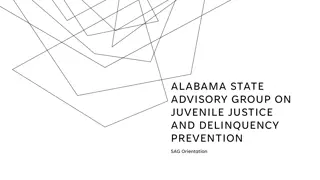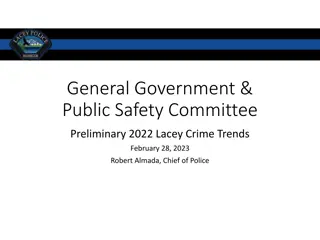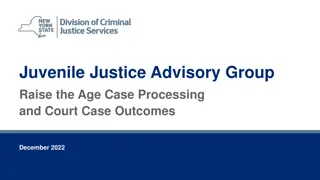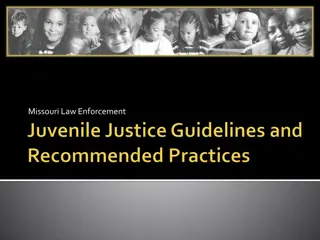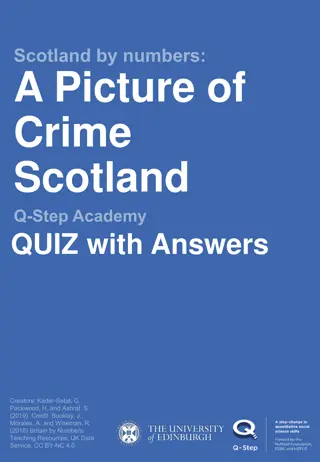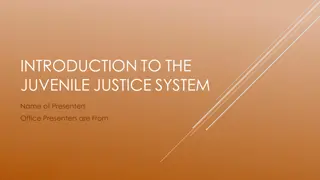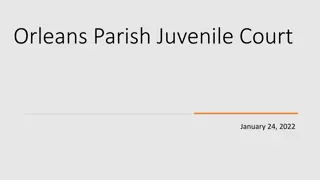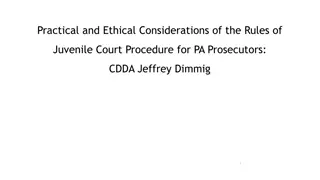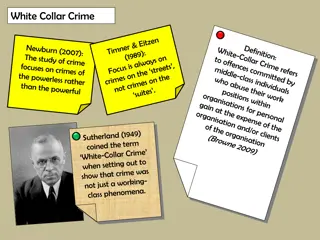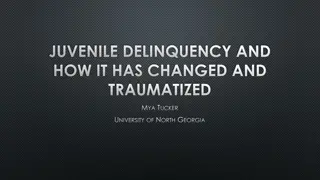Insights into Juvenile Delinquency and Crime Trends: A Comparative Analysis
Delve into a comprehensive analysis of juvenile delinquency trends across states in India, exploring the impact of state economic factors on crime rates. Uncover the intricate relationship between income levels, household dynamics, and juvenile crime incidence. Additionally, gain valuable insights into the broader landscape of crime economics and societal implications.
Download Presentation

Please find below an Image/Link to download the presentation.
The content on the website is provided AS IS for your information and personal use only. It may not be sold, licensed, or shared on other websites without obtaining consent from the author. Download presentation by click this link. If you encounter any issues during the download, it is possible that the publisher has removed the file from their server.
E N D
Presentation Transcript
Nabamita Dutta (U Wisconsin, La-Crosse) Dipparna Jana (CSSSC) Saibal Kar (Calcutta University and IZA, Bonn)
Delinquency among juveniles covers misdemeanor and felony as part of individual/group behavior. This is the first paper to show that incidence of juvenile crime across states in India is significantly explained by net state domestic product per capita rising when income grows and falling, once the state attains a critical per-capita income. If the percentage of arrested children belonging to households with annual income less than $400 increases, it enhances the state-wide incidence of juveniles committing property crime. States with higher percentages of arrested children coming from poorest households benefit more --- for these states one standard deviation rise in NSDP per capita raises crime by a smaller amount Adult crime nullifies the moderating impact of rising income on juvenile crime
Oliver Twist during industrial revolution in Britain to the graphic US- based 'Juveniles in Justice' by Richard Ross or to the most recent account of rape in New Delhi In USA, about 70,000 juveniles are detained on any given day (Aizer and Doyle Jr., 2013) and the combined public and private expenditure aimed at deterring crime amounts to about US100 bn. annually Concern of economists about crime is not a new phenomenon --- well known papers by Becker (1968), Fleisher (1966), Freeman (1996), Glaeser and Sacerdote (1999), Jacob and Lefgren (2003), Di Tella and Schargrodsky (2004), Williams and Sickles (2002), Levitt (1998, 2004), Lochner and Moretti (2004), Lee and McCrary (2005), etc. Complex literature in terms of a wide variety of influential factors. These studies include Levitt (1998), Levitt and Lochner (2001), Roman and Butts (2005), Mansour et al. (2006), United Nations (2010), Patachhini and Zenou (2012), Merlo and Wolpin (2015), Kang (2016).
To clarify various ambiguities with regard to impact of inequality on crime, Chisholm and Choe (2005) relate Gini and mean income of a given society with criminal activities - although, not juvenile crime However, what if criminals observe relative income or wealth rather than direct income, which is often unobservable? If information plays a significant role in criminal behaviour, then violent crime shall be based on observable wealth inequality but not on inequality in total expenditure (for US states, see, Hicks and Hicks, 2014). The infamous Nirbhaya incident in New Delhi in 2012, or the brutal murder of a standard XII student by his four minor friends in Greater Noida (near New Delhi) with police finding the body in Aligarh 27 Kms away impact on society ----- In India alone, the National Crime Records Bureau (NCRB) reports 100 to 300% rise in juvenile crime across cities and towns - between 2005 and 2014, the number of reported incidents went up from 18,939 to 33,526
Does this have a lot to do with rise in per capita income as well as inequality coupled with high illiteracy rates and school dropouts? Are regulations and punishments inadequate (law enforcement officers in many places agree that heinous crime committed by youth in the borderline of adulthood go under- punished)? Should one factor in the influence of adult crime and conformist group behavior among teens (see Patacchini and Zenou, 2012, Calvo-Armengol, Verdier and Zenou, 2007)? Levitt (1998, JPE) also takes up the incidence and persistence of juvenile crime and how it is influenced by several factors household income, parental education, adult crime rate, neighbourhood effects, etc . Evidence is from the US.
Available Answers Demombynes and Ozler (2005) for local inequality and crime in South Africa. The richer neighborhoods face on average 32% higher burglary rates. Inequality may also lead to violent crime. In Mexico, a one point increase in Gini coefficient leads to 36% rise in drug-related homicide an outcome of capturing larger territories in the municipalities (see Enamorado, et al, 2016). Kang (2016) shows that economic segregation across neighborhoods remain responsible for the correlation between violent crime and economic inequality Further, Mocan and Rees (1999) uses micro-data from high school (1995, Gallup survey) to investigate if neighborhood characteristics and deterrence policies have strong influence on incidence.
They find that an increase in violent crime arrests reduces the probability of selling drugs and assaulting someone for males, and reduces the probability of selling drugs and stealing for females An increase in local unemployment increases the propensity to commit crimes, as does local poverty For India, the government set an elaborate policy of attending to juvenile delinquency via The Juvenile Justice Act (henceforth, J. J. Act) of India, 1986 (amended in the year 2000). In principle, it was aimed at offering legal protection to children exposed to and participating in criminal activities The present paper accommodates a time scale whereby the reported incidences right before the Act was adopted by most states in India, and the longer period following that, is duly represented
A few state level graphical relations between net state domestic product and incidence of property crime, these tend to peak (except for Delhi) around the adoption and implementation of the Act, following which the downslide is directly observable
Figure 1: Association between per-capita NSDP and Incidences of Property Crime committed by Juveniles in six States in India, 2001-2013 35 25 30 20 25 15 20 15 10 9.5 10 10.5 11 9.2 9.4 9.6 9.8 10 10.2 logpc1 logpc1 proctd1 Fitted values proctd1 Fitted values Madhya Pradesh B. Gujarat
35 80 30 60 25 20 40 15 10 20 9.2 9.4 9.6 9.8 10 9.8 10 10.2 10.4 10.6 10.8 logpc1 logpc1 proctd1 Fitted values proctd1 Fitted values C.Uttar Pradesh D. Karnataka
60 60 50 50 40 40 30 30 20 10 20 9.8 10 10.2 10.4 10.6 10.6 10.8 11 11.2 11.4 11.6 logpc1 logpc1 proctd1 Fitted values proctd1 Fitted values E.West Bengal F. Delhi
Table 1: Incidences of Property Crime Committed by Juveniles across 17 Major States in India, 2001 and 2013 STATES 2001 813 214 85 473 412 623 274 90 145 58 704 1642 132 511 385 32 12 2013 1300 312 378 539 708 598 312 91 192 386 1083 2727 368 759 711 351 127 ANDHRA PRADESH ASSAM BIHAR CHATTISGARH DELHI GUJARAT HARYANA JHARKHAND KARNATAKA KERALA MADHYA PRADESH MAHARASHTRA ODISHA RAJASTHAN TAMIL NADU UTTAR PRADESH WEST BENGAL Source: National Crime Records Bureau, India
We adopt the standard NCRB reports definition throughout, by considering crime under Indian Penal Code (IPC) Violent crime includes murder, attempt to murder, kidnapping and abduction and hurt. Property crime includes burglary and theft Violent and property crimes represent a limited subset of all crimes. Omitted from these categories are all those crimes that are recorded under the Special and Local Laws (SLL). We shall focus relatively more on the violent and property offenses especially owing to the larger frequency associated with these at the state level
For our benchmark specifications we consider, the household income of the arrested children, incidences of adult crime and incidences of children arrested and sent to court Importantly, the general observation from the data is that the incidence varies substantially across states and across important cities. Therefore, the state-level characteristics, distribution of household income, education, depth and spread of law enforcement, mean employment status, presence of juvenile homes, etc have been considered. The explanatory variables include, the net state domestic product (NSDP) and estimated mid-year population as taken from the Central Statistic Organization (CSO, GoI).
According to the Annual Report of Women and Child Development Department, Government of West Bengal (GoWB), 2010-2011 the state has a foolproof child protection mechanism in terms of JJBs, Child Protection Committee, Special Juvenile Police Unit and a child protection society in every district. The budget for children from 2007-08 to 2011-12 reveals that regarding sectoral allocation child protection is somewhat neglected with average percentage in total state budget being only 0.05%. In West Bengal, Department of Women and Child Development and Social Welfare is the nodal department. Both in the case of Government and NGO run homes notified under JJ Act, GoWB allocated Rs. 1100 per child per month for their up keep. Out of that, Rs. 250 is contributed by Government of India before Integrated Child Protection Scheme (ICPS) norms were formulated.
In West Bengal as per the Juvenile Justice Act 2000 there are 18 existing Government run Homes and 21 existing NGO run homes. District-wise distribution of Homes are HOMES UNDER JJ ACT 2000 DISTRICT Bankura Burdwan Coochbehar Darjeeling South Dinajpur Howrah Hooghly Jalpaiguri Kolkata Malda Murshidabad Nadia North 24 Pargana West Midnapore East Midnapore Purulia South 24 Pargana North Dinajpur GOVERNMENT 1 1 2 0 1 1 1 1 1 1 3 1 2 1 0 1 0 0 NGO 1 1 0 3 2 2 2 3 8 0 0 0 2 1 3 0 2 2
The share of employment across states is taken from the NSSO 61st (2004-2005) and 66th (2009-2010) round survey (Working group on 12th Plan Employment, Planning and Policy). We estimate the following specification (state fixed effects): J ( ) = 2 = + JuvCrime 1 + + + + 4 + 5 + JuvCrime NSDP NSDP X 0 1 2 3 it it it it j jit i t it 1 j
Here JuvCrimeit is the percentage of juveniles committing property crime out of total estimated mid-year population for state in time t. JuvCrimeit-1 is the measure of such incidences lagged one period (persistence effect). It enables us to capture the persistence of the dependent variable. NSDPit denotes the logarithm value of per-capita net state domestic product for state i in time t. (NSDPit)2aims to capture the non-linear impact of the net state domestic product on the incidences of juveniles committing property crime. Xjit is the matrix of control variable used, such as state specific per-capita police strength, mean employment status, annual household income of the arrested children, incidences of adults committing property crime and the deterrence factor in the form of percentage of children arrested and sent to court out of total mid-year population. is the state fixed effect, is the time specific effect
Table 1: Property Crimet-1 (1) (2) -0.0153 (0.0195) 6.594*** (2.460) -0.324*** (0.120) (3) -0.0102 (0.0185) 11.09*** (2.679) -0.441*** (0.121) (4) -0.0103 (0.0186) 11.14*** (2.688) -0.445*** (0.121) (5) -0.0129 (0.0188) 11.31*** (2.696) -0.451*** (0.122) (6) -0.00943 (0.0178) 15.30*** (2.692) -0.653*** (0.123) NSDP per-capita 6.435*** (2.155) -0.310*** (0.105) -28.51*** (1.206) 3.115*** (0.117) (NSDP capita)2 per- Police Strength -28.44*** (1.318) -24.74*** (1.486) -24.74*** (1.489) -24.60*** (1.499) -21.24*** (1.595) (Police Strength)2 3.120*** (0.127) 2.703*** (0.152) 2.706*** (0.152) -0.00173 (0.00369) 2.694*** (0.153) -0.00110 (0.00376) 2.332*** (0.165) 0.000186 (0.00356) Illiterate Year Dummies Income <=250000 Adult Crime No No Yes Yes Yes -0.00277 (0.00308) Yes -0.00104 (0.00293) 0.224*** (0.0489) Property Deterrence Constant Observations R-squared Number of States 32.34*** (9.472) 217 0.931 17 31.69*** (10.81) 201 0.934 17 -8.971 (14.80) 201 0.948 17 -10.99 (15.19) 201 0.948 17 -12.36 (15.24) 201 0.948 17 -40.31** (15.64) 201 0.954 17 *** p<0.01, ** p<0.05, * p<0.1
NSDP and NSDP2 are significant for all specifications. The sign of the coefficient of NSDP and NSDP2 implies that state domestic product has a concave relationship with the level of incidences of juveniles committing property crime The lagged variable has a negative but insignificant impact. Per-capita police strength and its square term are significant and represents a convex relation with the dependent variable With a rise in police strength for a state, the incidences of juveniles committing property crime declines but the rate of decline occurs at an decreasing rate children and teens not too afraid of the police?
To explore the second part of the study, i.e., the impact of state income on the incidences of property crime committed by the juveniles conditioned upon the other state specific factors that can also influence such incidences, we consider the following empirical specification ( ) ( ) 2 = = + JuvCrime 1 + + + + * JuvCrime NSDP NSDP w NSDP w 0 1 2 3 4 5 it it it it kit it kit J + + 6 + 7 + X j jit i t it 1 j
As in the previous econometric specification JuvCrimeit is the percentage of juveniles committing property crime out of total estimated mid-year population for state i in time t. JuvCrimeit-1is the measure of such incidences lagged one period and (NSDPit)2 capturing the non-linear impact of the net state domestic product. Xjit is the matrix of control variable used, effect and the time specific effect respectively w is the household income strata to which the children belongs and being the state fixed- kit
A vector of variables represented as value 1 to 4. w are interacted with NSDPit, where k takes the kit w1represents the percentage of arrested children belonging to household annual If k = 1, income <25000. This variable can act as a proxy for the inequality of income distribution among the households of all the children who are being apprehended . it w2will represent the percentage of adults committing property crime. For k = 2, it w3represents the percentage of children arrested and sent to court and if k = 4, If k = 3, w4will represent the state specific employment share in agriculture, manufacturing and service sector. it it Considering the interactive impact of household income of the arrested children and NSDP on the incidences of property crime committed by the juveniles, we estimate equation (2) by putting k = 1.
Table 2: Property Crimet-1 (1) -0.0121 (0.0189) 14.29*** (3.178) -0.570*** (0.139) (2) -0.0142 (0.0185) 11.23*** (2.661) -0.434*** (0.120) (3) -0.00106 (0.0168) 11.88*** (2.665) -0.543*** (0.119) (4) -0.00655 (0.0124) 4.192** (1.854) -0.183** (0.0836) NSDP per-capita (NSDP per-capita)2 Police Strength -25.08*** (1.526) -24.46*** (1.483) -15.79*** (1.950) -2.710 (2.094) (Police Strength)2 2.735*** (0.155) 2.657*** (0.152) 1.720*** (0.208) 0.299 (0.226) Household Income?25000 NSDP*HH Income 0.0746* (0.0440) -0.00760* (0.00431) Illiterate -0.00138 (0.00377) -0.000675 (0.00370) -0.000866 (0.00336) -0.00444* (0.00249) Homeless -0.00131 (0.00594) -0.000421 (0.00577) -0.00430 (0.00529) 0.00600 (0.00394) Year Dummies NSDP*Employment Yes Yes -0.540** (0.224) Yes Yes Adult Property Crime -1.686*** (0.431) NSDP*Adult Property Crime Deterrence 0.181*** (0.0407) -0.216* (0.122) 0.0352*** (0.0109) -16.79* (10.12) NSDP*Deterrence Constant -29.07 (17.91) -7.827 (14.69) -28.59* (15.07) Observations R-squared Number of States 201 0.949 17 *** p<0.01, ** p<0.05, * p<0.1 201 0.949 17 201 0.959 17 201 0.977 17
From Table 2, in column (1) the lagged variable is still negative but insignificant. w1 is positive and significant. The coefficient of it It implies that if the percentage of children arrested belonging to household with annual income<25000 increases it further enhances the incidences of juveniles committing property crime. w * 1 NSDP The coefficient of our interaction term is negative and significant. it it The sign of the coefficient of interaction term suggests that for a given level of NSDP, a unit rise in the percentage of children arrested and sent to court from the household with annual income less than 25000, lowers the incidences of juveniles committing property crime.
For example, In order to fully understand the impact we need to consider the following partial derivative. JuvCrime = + (i) NSDP it 4 5 it w 1 it We find that for all states, whose logarithm value of per-capita NSDP 9.815, the impact of rise in delinquent children belonging to poor household on juvenile crime becomes negligible or declines.
For a given state it may so happen that an overwhelmingly large number of arrested children originate in households in the lowest income bracket (33% for Uttar Pradesh). In another state, this proportion may be 7%, only (Gujarat). We argued that this might have to do with the per capita income level of a particular state. Subsequently, these shares were interacted with the state level per capita income. We showed that for the first kind of state, an equivalent rise in per capita NSDP is much more beneficial than that enjoyed by the second kind of state.
Table 4: Marginal Effect of NSDP per capita on Juvenile Crime at different percentages of household incomes of arrested children where income < Rs.25000 Value of 33.1 Percentile of 1 10th Estimates States , 1 it it 2.41*** (0.54) 2.29*** (0.52) 2.17*** (0.51) 2.07*** (0.51) 2.02*** (0.51) 2.19*** (0.51) Uttar Pradesh 25th 47.99 Haryana 50th 64.85 Madhya Pradesh 77.29 75th Andhra Pradesh 84.67 90 Gujarat 61.58 Mean Bihar *** p<0.01, ** p<0.05, * p<0.1 Note: evaluated at various values of . Specifically, we 1 it at the 10th, 25th, 50th, 75th and 90th and the mean of estimate , income based on the estimates from 1 it Table 3.
We also considered the propensity of adult crime and state-specific employment share in explaining the differential impact at the state level. We showed that the influence of adult crime is positive and significant on preponderance of juvenile crime. Our results further show that state income does not necessarily act as a moderator in terms of peer and deterrence effects. Interestingly, we found that while deterrence has an expected direct negative impact on juvenile crime, interaction with per capita NSDP counters the beneficial impact. A richer state may witness rise in delinquency if they raise the degree of deterrence. In this regard, one needs to explore further the somewhat fuzzy line between crime deterrence and repression in a given society.
